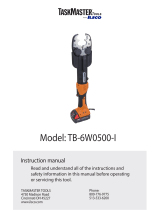
4
RAPID CHARGER
WARNING
WARNING
To reduce the risk of injury or ex-
How to Charge the Battery Pack
Maintenance and Storage
Do not expose your battery pack or cordless tools
to water or rain, or allow them to get wet. This could
damage the tool and battery pack. Do not use oil or
solvents to clean or lubricate your battery pack. The
plastic casing will become brittle and crack, causing
a risk of injury.
plosion, never burn or incinerate a
battery pack even if it is damaged, dead or com-
pletely discharged. When burned, toxic fumes
and materials are created.
Disposing of MILWAUKEE
®
Li-Ion
Battery Packs
Even discharged battery packs contain some energy.
Before disposing, use electrical tape to cover the
terminals to prevent the battery pack from shorting,
Store battery packs at room temperature away
from moisture. Do not store in damp locations
where corrosion of terminals may occur. As with
other battery pack types, permanent capacity loss
can result if the pack is stored for long periods of
time at high temperatures (over 48°C).
MILWAUKEE
®
Li-Ion battery packs maintain their
charge during storage longer than other battery
pack types. After about a year of storage, charge
the pack as normal.
MILWAUKEE
®
Li-Ion battery packs are more
environmentally friendly than some other types of
Charge only MILWAUKEE
®
M18™
Li-Ion batteries in this
MILWAUKEE
®
Li-Ion charger. Other types of
batteries may cause personal injury and
damage.
When to Charge the Battery Pack
with this
MILWAUKEE
®
Charger
Remove the battery pack from the tool for
charging when convenient for you and your
job. MILWAUKEE
®
batteries do not develop a
"memory" when charged after only a partial
discharge. It is not necessary to run down the
battery pack before placing it on the charger.
• Use the Fuel Gauge to determine when to
charge your MILWAUKEE
®
Li-Ion battery
pack.
• You can "Top-Off" your battery pack's charge
before starting a big job or long day of use.
• The only time it is necessary to charge the
MILWAUKEE
®
Li-Ion battery pack is when the
battery pack has reached the end of its
charge. To signal the end of charge, power to
the tool will drop quickly, allowing you just
enough power to finish making a cut, drilling a
hole, or driving a fastener. Charge the battery
pack as needed.
Align the battery pack with the bay and slide the
battery pack into the charger as far as possible. The
red light will come on, either flashing quickly
(battery
pack is too hot or cold), flashing slowly (battery
pack is waiting for another pack to finish charging)
or continuous (pack is charging).
• A fully discharged battery pack with an internal
temperature in the normal range will charge in
about 25 to 130 minutes, depending on the battery
pack.
• Heavily cycled batteries may take longer to charge
completely.
• The Fuel Gauge lights on 18V battery packs are
displayed as the pack is being charged, indicating
how fully charged the pack is. The fuel gauge will
turn off when charging is complete.
• After charging is complete, the continuous green
light will come on.
• The charger will keep the battery pack fully
charged if it is left on the charger. The light indicator
will flash green during this maintenance charging.
• If the light indicator flashes red and green, check
that the battery pack is fully seated into the bay.
Remove the battery pack and reinsert. If the light
continues to flash red and green, remove pack(s)
and unplug charger for at least 2 minutes. After 2
minutes, plug charger back in and insert pack. If the
problem persists, contact a MILWAUKEE
®
service
facility.
WARNING
injury, and product damage due to
a short circuit, never immerse your tool, battery
as seawater, certain industrial chemicals, and
bleach or bleach containing products, etc., can
cause a short circuit.
Cold Weather Operation
MILWAUKEE
®
Li-Ion battery packs are designed to
operate in temperatures below freezing. When the
battery pack is too cold, it may need to warm up
before normal use. Put the battery on a tool and
use the tool in a light application. It may “buzz” for a
short time until it warms up. When the buzzing
stops, use the tool normally.
Fuel Gauge Lights Diagnosis Solution
Lights 1 - 4 Solid Remaining run time Continue working
slowly
Less than 10% run
time left
Prepare to charge pack
quickly
End of discharge Charge pack
quickly
Current draw too
high
Release trigger and
restart, reduce pressure
Lights 1&3 / 2&4,
Battery temperature
too high
Release trigger and allow
battery to cool
Battery Pack Protection
To protect itself from damage and extend its life, the
battery pack’s intelligent circuit monitors current
draw and temperature. In extremely high torque,
binding, stalling, and short circuit situations, the
battery pack will turn OFF the tool if the current
draw becomes too high. All the fuel gauge lights will
flash. Release the trigger and restart.
Under extreme circumstances, the internal
temperature of the battery could become too high. If
this happens, the fuel gauge lights will flash in an
alternating pattern and the tool will not run. Allow
the battery to cool down.
power tool battery packs (e.g., nickel-cadmium).
Always dispose of your battery pack according to
federal, state and local regulations. Contact a
recycling agency in your area for recycling
locations.
NOTE: Immediately after using the battery pack,
the Fuel Gauge may display a lower charge than it
will if checked a few minutes later. The battery cells
"recover" some of their charge after resting.









